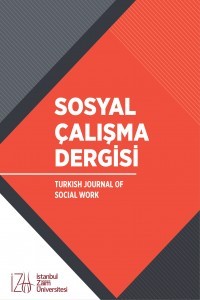Virtual Social Work with Families during Pandemic: A Classical Approach with a Modern Technique
Pandeminin psikososyal yönleri, sanal sosyal çalışma, Satir'in aile modeli, pandemi ve ailelerle çalışma
___
- Banmen, J. (2002). The Satir model: yesterday and today. Contemporary Family Therapy, 24, 7–22
- Banmen, J. (1986). Virginia Satir's family therapy model. Individual Psychology: Journal of Adlerian Theory, Research & Practice, 42(4), 480-492.
- Barak, A. Grohol, J.M. (2011). Current and future trends in Internet-supported mental health interventions. Journal of Technology in Human Services, 29(3),155-196.
- Beaudry, G. (2002). The family reconstruction process and its evolution to date: Virginia Satir's transformational process. Contemporary Family Therapy, 24, 79-91.
- Brooks, S.K., Webster, R.K., Smith, L.E., Woodland, L., Wessely, S., Greenberg, N., & Rubin, G. (2020). The psychological impact of quarantine and how to reduce it: rapid review of the evidence. Lancet, 395, 912–920.
- Castelnuovo, G. Andrea Gaggioli, Fabrizia Mantovani, and Giuseppe Riva. (2003). From psychotherapy to e-therapy: the integration of traditional techniques and new communication tools in clinical settings. CyberPsychology & Behavior.Aug, 6(4), 375-382.
- Çelebi, V. & İnal, A.(2020). Covid-19 Pandemisini felsefi açıdan değerlendirmek ve anlamak. Turkish Studies, 15(6), 297-322.
- Clark H, Coll-Seck AM, Banerjee A, et al. (2020). A future for the world’s children? A WHO–UNICEF–Lancet Commission. Lancet, 395: 605–58. Cluver, L. et al. (2020). Parenting in a time of COVID-19. Lancet, 395:e64.
- Connell, C. M., & Strambler, M. (2020). Studying the unintended consequences of COVID-19 responses on family wellbeing and child safety. Yale School of Medicine.
- Cook, L. L. & Zschomler, D. (2020) Child and family social work in the context of COVID-19: practice issues and innovations. Briefing Paper. Norwich: CRCF.
- Emlen S T. (1995). An evolutionary theory of the family. Proceedings of the National Academy of Sciences, 92 (18), 8092-8099.
- Getz, L. (2018). Social services innovations: a whole new world: virtual reality in social work. Social Work Today, 18(2), 6.
- Heather A.W.M. (2020). Coronavirus pandemic calls for an immediate social work response. Social Work in Public Health, 35(3), 69-72.
- IFSW (International Federation of Social Workers) (2020). Ethical Challenges for Social Workers during COVID-19: A Global Perspective. IFSW.
- Last, JM (2001). A dictionary of epidemiology, 4th edition. New York: Oxford University Press.
- Manhal-Baugus, M. (2001). E-therapy: practical, ethical, and legal issues. CyberPsychology & Behavior, 4(5), 551-563.
- Mattison M. (2012). Social work practice in the digital age: Therapeutic e-mail as a direct practice methodology. Social Work, 57(3):249–258.
- Peters, M. A.(2020): Love and social distancing in the time of Covid-19: The philosophy and literature of pandemics, Educational Philosophy and Theory, DOI: 10.1080/00131857.2020.1750091
- Reamer, F.G. (2020). Virtuous virtual social work. Social Work Today Magazine. Retrieved from: https://www.socialworktoday.com/news/eoe_0520.shtml. 01.12.2020.
- Satir, V., Banmen, J., Gerber, J., & Gomori, M. (1991). The Satir model: Family therapy and beyond. Palo Alto, CA: Science and Behavior Books
- Tam, B., Findlay, L. C., Kohen, D. (2017). Conceptualization of family: complexities of defining an Indigenous family. Indigenous Policy Journal, 28(1), 483-502.
- Turtiainen, P. ,Karvonen, S. & Rahkonen, O. (2007) all in the family? the structure and meaning of family life among young people. Journal of Youth Studies, 10:4, 477-493.
- Usher, K. et al. (2020). Family violence and COVID‐ 19: Increased vulnerability and reduced options for support. International Journal of Mental Health Nursing, 29, 549-552.
- WHO (World Health Organization) (2020). COVID-19 and violence against women. What the health sector/system can do. Retrieved from https://www.who.int/reproductivehealth/publications/emergencies/COVID-19-VAW-full-text.pdf. 24.11.2020.
- Wodarski, J. & Frimpong, J. (2013). Application of e-therapy programs to the social work practice. Journal of Human Behavior in the Social Environment, 23(1), 29-36.
- Yayın Aralığı: Yılda 2 Sayı
- Başlangıç: 2017
- Yayıncı: İstanbul Sabahattin Zaim Üniversitesi
Virtual Social Work with Families during Pandemic: A Classical Approach with a Modern Technique
Türkiye ve Avrupa’da Denetimli Serbestlik Sisteminin Yönetim Yapısı
Talip ERYALÇIN, Mehmet BİRİNCİ
Ayfer DAĞCE, Taner ARTAN, Hatice Selin IRMAK
Görme Engelli Bireylerin Engellilik Deneyimleri Üzerine Bir Değerlendirme
Sosyal Hizmet Uzmanlarının Mesleki Uygulama Düzeylerinin Belirlenmesi
Ayten KAYA KILIÇ, Hasan H. TEKİN
Toplumla Çalışma Bağlamında Savunuculuk
Sosyal Hizmet ve İnsan Hakları: Eleştirel Bir Bakış
Gençlerde Alkol Kullanımı ve Kültürel Yapının Bağımlılığa Etkisi
Edanur AKGÜMÜŞ, Deniz BALLANLI, Şuheda BİRBEN, Alara DADAYLI, Aysel İklim SAKINÇ, Özge ÖZTÜRK, Merve Deniz PAK GÜRE
